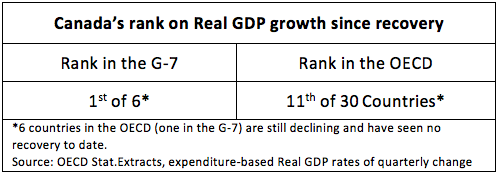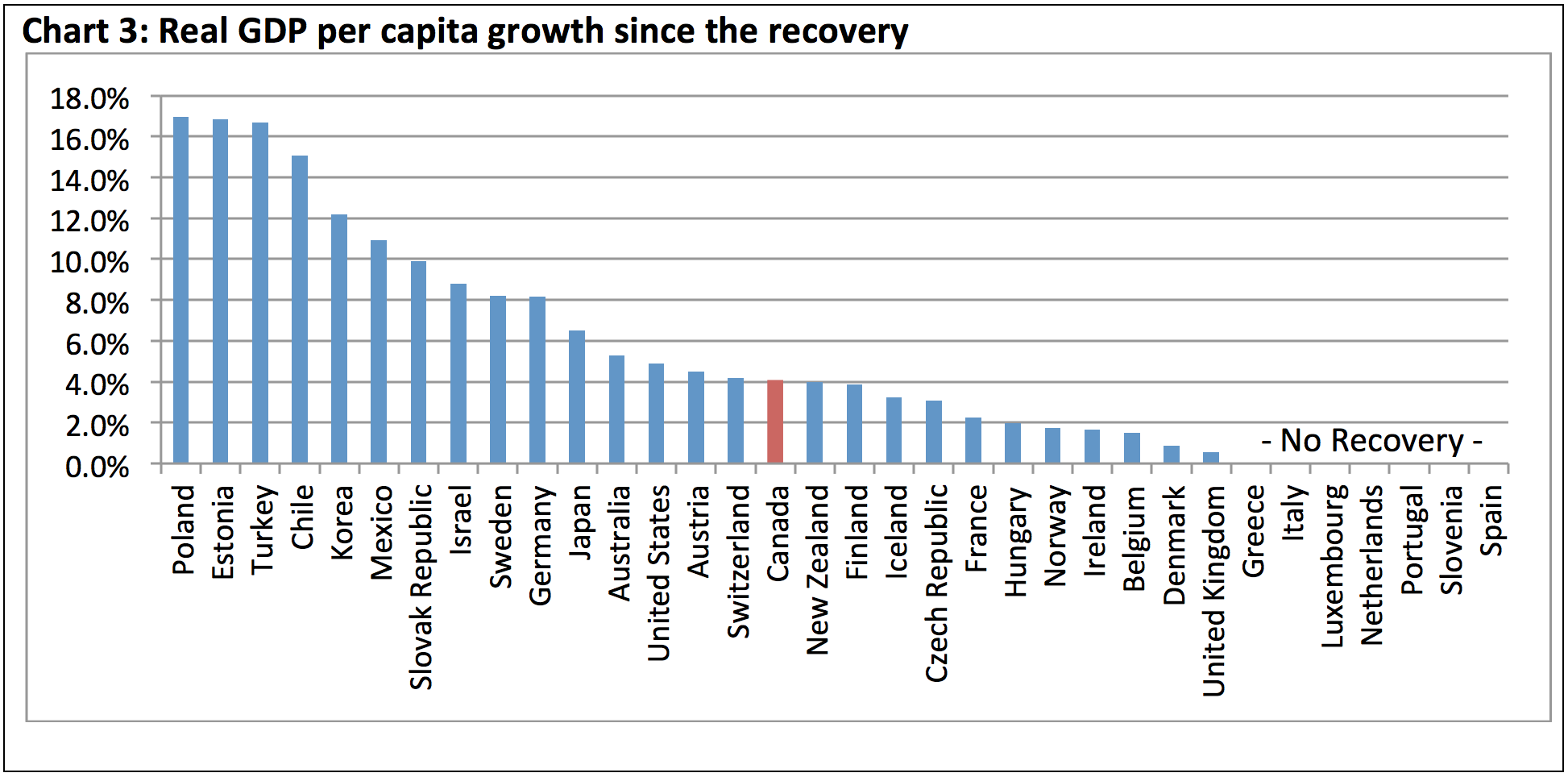“Among Group of Seven (G-7) countries, such as the U.S., Germany and Japan, Canada has had the strongest record of growth and job creation over the economic recovery.” - 2013 Budget
“Canada now leads the G-7—in job creation; in income growth; and in keeping debt levels low.” - Speech from the Throne, October 2013
“Our job creation is the envy of other advanced countries…” - 2011 Budget Speech, June 6, 2011
It is now more than four years after the technical end of Canada’s recession and, according to the Government of Canada, the economy is doing great.
But how accurate is that message? Is Canada’s economy the best in the world?
Over the next several days, CCPA’s blog Behind the Numbers, will publish a series examining Canada’s economic recovery across several more representative indicators and scrutinizing the government’s economic message. Today's post will feature two parts: a brief introduction to the government’s message, and an analytical look at ‘Economic Growth’ and per-capita-GDP. Tomorrow’s analysis will focus on jobs and unemployment, while Wednesday and Thursday’s analysis will look at the quality of employment since the recession.
Prior to the Update of Economic and Fiscal Projections, the federal government has based its upbeat message on Canada’s ranking in the G7 using only two main indicators: percentage growth in real gross domestic product (GDP) growth and total employment since the lowest-point of the recession[1] (called a trough in economic terms). For good measure the fall update also includes growth in real per capita disposable income, however instead of using the trough to present comparison, a 2006 to present comparison is used. It appears that only indicators, comparison groups and methodologies that place Canada first are published.
However, these comparisons are inherently limiting. First, they only focus on limited aspects of the labour market and national wealth; second, the government’s methodology changes from comparison to comparison; third, the reference group of the G-7 is narrow when examining the experience of industrialized countries in general.
These posts will retain an identical trough-to-current methodology to the government. This means that, in each measure, recovery is defined as the improvement from a country’s worst point on each measure to its most recent value. For some countries, like Italy, unemployment has continued to worsen since the recession and as such there has not yet been a recovery in that measure.
And all comparisons are made within the OECD, thus providing a richer comparison group. Unlike the G-7, the OECD’s 34 members represent the majority of the developed world and can serve as a proxy for the worldwide experience of developed countries during the recession and recovery. The OECD accounts for 59% of the world’s GDP and three-quarters of international trade flows.
All OECD countries are ranked on their recovery for each measure, and from this we will create an ‘economic report card’. Grades are then assigned based on that ranking with the bottom 25% receiving an F, the next 6.25% receiving a D- and so on. More details on the grading and evaluation methodology are available here.
With better measures and a more representative international comparison, Canada’s economic recovery is much less rosy than the spin doctors would have us believe – and is certainly not the best in the world.
In fact, by some measures, Canada’s recovery actually ranks relatively poorly to the OECD.
“Growth” – GDP Recovery?
The 2013 Budget says that Canada leads the G-7 in “growth,” something also referred to in the recent Speech from the Throne. By 'growth' the government is referring to economic growth in real GDP since the trough of the recession. Notwithstanding the various problems with GDP, in this unmodified form, it doesn’t account at all for population growth. Nor does it adjust for the changing purchasing power of consumers in different countries. While the 2013 Budget highlights Canada’s 1st in the G-7 for real GDP growth since the recessionary trough, a broader OECD comparison tells a much different story. Within the OECD, Canada’s real GDP recovery only ranks 11th out of 34 countries. Canada is being beaten out by countries such as Israel, Australia, and Sweden, among others that aren’t included in the G-7 comparison.
While the 2013 Budget highlights Canada’s 1st in the G-7 for real GDP growth since the recessionary trough, a broader OECD comparison tells a much different story. Within the OECD, Canada’s real GDP recovery only ranks 11th out of 34 countries. Canada is being beaten out by countries such as Israel, Australia, and Sweden, among others that aren’t included in the G-7 comparison.
However, looking solely at GDP growth does not provide an accurate and full picture of Canada’s national wealth, as it doesn’t include population growth. If GDP growth is only equivalent to population growth, it is difficult to say that Canadians are better off. Rather, the average Canadians’ access to economic output, jobs and standard of living is constant in this case. In order to have an increasing standard of living for the average Canadian, real GDP growth must exceed population growth, thereby providing more economic output on a per-person basis. Therefore, real GDP per capita is a better measure of how the economy is doing in terms of increasing Canadians’ standard of living over time (although it doesn’t account for income inequality).While the 2013 Budget highlights Canada’s 1st in the G-7 for real GDP growth since the recessionary trough, a broader OECD comparison tells a much different story. Within the OECD, Canada’s real GDP recovery only ranks 11th out of 34 countries. Canada is being beaten out by countries such as Israel, Australia and Sweden among others that aren’t included in the G-7 comparison.
Canada’s population is one of the fastest growing in the developed world, with the working age population increasing at a rate of 1.3% a year. Canada has the fastest population growth in the G-7 and the 8th fastest of the 34 OECD countries[2]. While Canada’s economic ‘pie’ might be growing, so is the number of people who get a slice.
For example Canada and Germany have experienced very similar real GDP increases since the recessionary trough. However, Germany’s population is shrinking, decreasing at an average of 0.1% annually. Since the German population has shrunk slightly since the recession, their GDP growth is shared between fewer people – which means per capita GDP growth is actually faster than aggregate GDP growth. Canada has experienced much higher population growth meaning many more people share Canada’s GDP.
The comparison between OECD countries is further complicated by changing purchasing power of consumers. Not only are real GDP per capita figures changing over time, but the currencies in which they are denominate are also changing. For instance, real GDP per capita might have risen in a country at the same time as the purchasing power of its consumers has fallen, erasing any gains. As such, the purchasing power of consumers is normally included in international comparisons.
Once population growth and purchasing power are taken into account, Canada’s economic picture starts looking very different than the official line from Ottawa.
 Source: OECD.StatExtracts, GDP per head in constant US $ PPPs (http://stats.oecd.org/index.aspx?queryid=558)
Source: OECD.StatExtracts, GDP per head in constant US $ PPPs (http://stats.oecd.org/index.aspx?queryid=558)
 After adjusting for population growth and equalizing purchasing power, Canada’s real GDP per capita growth over the recovery has been just 4.1%. This is well below the OECD average of 5.2%.
After adjusting for population growth and equalizing purchasing power, Canada’s real GDP per capita growth over the recovery has been just 4.1%. This is well below the OECD average of 5.2%.
By this measure, Canada ranks 4th in the G-7, behind Germany, Japan and the United States.After adjusting for population growth and equalizing purchasing power, Canada’s real GDP per capita growth over the recovery has been just 4.1%. This is well below the OECD average of 5.2%.
Within the broader sample of industrialized countries Canada again sits in the middle at 16th of the 34 countries in the OECD. Translated into a letter grade using the grading methodology, Canada receives a C. Our economy’s ability to produce wealth for Canadians is better than countries like Greece and Italy where per capita GDP is still falling, but the economies of ten OECD countries have at least doubled our per capita wealth creation.
In terms of “growth”, Canada is clearly not the leader of the pack nor “the envy of the world.” At best, the Canadian recovery has been slightly below average.
To learn more about the methodology behind this blog series, click here.
Kayle Hatt is the Canadian Centre for Policy Alternatives’ 2013 Andrew Jackson Progressive Economics Intern.







